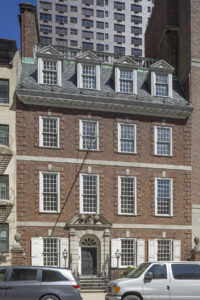Building Name
The National Society of Colonial Dames
Architect
Richard Henry Dana, Jr
Year(s) Built
1930

Project Information:
Colonial Revival style townhouse designed by Richard Henry Dana, Jr and constructed in 1930. Application for Landmark designation.
CB8 Hearing: 01/08/18
LPC Hearing: 05/21/19 (Motion to Close Public Hearing)
LPC Meeting: 06/11/19 (Motion to Designate)
FRIENDS' Testimony:
FRIENDS of the Upper East Side is delighted to support the designation of the National Society of Colonial Dames in the State of New York Headquarters building as an individual landmark as well as a rare interior landmark.
The clubhouse of the National Society of Colonial Dames is a fine example of elements that define the Colonial Revival style that was similarly favored by clubs and upscale private homes through the late 19th and early 20th Century in Manhattan, sparked in part due to a renewed interest in the Colonial era amid the United States’ Centennial celebrations of the nation’s founding in 1876 and the adoption of the U.S. Constitution in 1887.
Contemporaneous to these celebrations, the National Society of Colonial Dames of America was founded in 1891 as a women’s organization dedicated to promoting national heritage and Colonial history in particular. The Society has since been dedicated to protecting and promoting this heritage through historic preservation, patriotic service, and educational programs. The group has been committed to preserving New York State’s Colonial roots through its social and educational work and in 1896, the Dames became stewards of the Van Cortlandt House Museum in the Bronx, an Individual Landmark.
The portion of the Upper East Side that extends east of Lexington Avenue was becoming fashionable in the 1920’s and the Society’s home at 215 East 71st Street joined other upscale residences and social buildings, including the Junior League’s clubhouse built by John Russell Pope at neighboring 221 East 71st Street. The members of the National Society of Colonial Dames were among the early proponents of historic preservation and indeed the house is a testament to their commitment to honoring and highlighting the notable legacy of New York State’s Colonial era through its architecture. An announcement from November 1930 announcement in the New York Times spoke of the Dames’ “new home…typical of Pre-Revolution Days” that was to house “Relics, Furniture, and Paintings of 18th Century New York.”
When the Society planned to move from its original home at 24 East 63rd Street, it reportedly could not find a suitable building from the Colonial period to use. Thus, they decided to construct a new building that would be outwardly express the organization’s mission and celebrate the built form that was prevalent at the time of the nation’s founding. The Society commissioned Richard Henry Dana IV, an architect noted for his excellence in Colonial Revival architecture in New York and New England, to design the building in 1928, and Dana sought to design a new building that would emphasize “another age and in a modern setting [evocative of] the ‘dignified and charming way in which our forebears lived.’” Each of the design elements were chosen deliberately to echo the appearance of notable pre-Revolutionary sites. The design was largely based on the John McEvers house which once stood at 34 Wall Street (later demolished for the Gallatin Bank building, and later still, the landmarked National Bank Building).
In addition to the house at 34 Wall Street, an effort was made to incorporate details from Colonial era buildings elsewhere in New York State, reflecting the focus of the New York chapter of the Society. The plum colored brick recalls the Schuyler Mansion in Albany, and the door and fanlight were inspired by the Philipse Manor in Yonkers—which was constructed by Jacobus Van Cortlandt and Eva Philipse, whose son Frederick built the Van Cortlandt mansion that was later purchased by the Colonial Dames for use as a museum. Additionally, the fifth-floor dormers were adapted from the typical scale and appearance of 18th century New England homes. These evocative elements coalesce on the facade and the building stands as an amalgam, of sorts, of the Colonial Style, of which there are few examples surviving in New York City. These inspirations were seamlessly merged to create a primary facade that deftly recreated and exemplified the Colonial past through Revivalist architecture.
The building has been meticulously maintained and serves the community as a house museum and popular location for educational tours, and it is still in use as the Colonial Dames’ primary clubhouse and event space. The group has been an exemplary steward of 215 East 71st Street, which has not been altered significantly since its construction. In fact, it can be said that the evocative Colonial Revival facade thoughtfully reflects the heritage being celebrated, preserved and taught by the members of the Society inside. The facade of 215 East 71st Street pays homage to the Colonial history of New York State, a history that the Society of Colonial Dames has been committed to preserving since its inception. FRIENDS believes this hard work is commendable and deserves to be supported by local designation, which will ensure that these conditions will be maintained and celebrated in perpetuity. Due to the Society’s important history and architectural merit, this building deserves designation as an individual landmark.
Interiors
The National Society of Colonial Dames clubhouse interiors are equal parts ode to the Colonial era design ethic and shrine to historic preservation. The interior maintains many of its Georgian and Colonial Revival details and contains a vast collection of significant Colonial items and ephemera that have been meticulously maintained for nearly a century at 215 East 71st Street.
Much like the building’s massing and facade design, the interior features of the National Society of Colonial Dames clubhouse either replicate or draw inspiration from prominent Colonial sites throughout the Northeast of the United States, as well as typical Georgian homes in Great Britain. The Colonial Revival style is a luxurious interior fashion that recalls the craftsmanship of early American architecture. For example, the balusters replicate the design of those from the John Hancock house in Boston, built in 1740; the Palladian window overlooking the rear gardens matches the mansion home of Benedict Arnold, built originally in 1761 for Scottish Privateer John Macpherson in Philadelphia; and the garden balcony copies the old State House in Boston, to name a few. More holistically, the defining features of 18th Century style sensibility such as multi-light windows, paneled doors, crown moldings, robust, dimensional paneling and silk wallpaper were deftly applied to this 1929 building to express the unique sense of residential Colonial style in a manner that would not impede or prevent the Society’s programmatic needs or educational mission.
This singular mix of authentic 18th century objects and ephemera and skillful tribute to pre-Revolutionary design through Colonial Revival architecture that has been preserved inside of 215 East 71st Street is unique in New York City, and exemplify the Colonial Revival sensibility, little of which has been preserved elsewhere in the City. This collection of rooms is deserving of the highest standard of preservation as a designated interior landmark.

